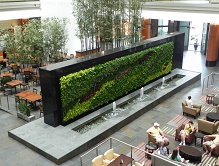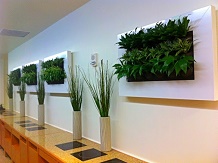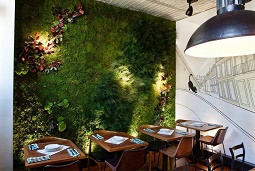 NATIONAL REPORT—Green walls, also known as vertical gardens or living walls, increasingly are being used in interior and exterior areas of hotels to make a green design statement. Aside from being aesthetic symbols of a property’s commitment to sustainability—perhaps even a means to earn LEED credits—green walls offer many other benefits. They can help deaden sound in large spaces, absorb and clean toxins from the air, reduce carbon dioxide levels, keep air temperatures down, improve employee alertness and energy levels, increase humidity, reduce airborne dust levels, and even help increase the property values of commercial buildings. According to Ambius, a green walls design expert, exterior green walls can reduce wall surface temperatures by as much as 50 degrees Fahrenheit, resulting in significant energy savings and air-conditioning costs. Green walls can be massive in size and expand over multiple floors, or as small as a framed piece of art—what Ambius calls its LivePicture.
NATIONAL REPORT—Green walls, also known as vertical gardens or living walls, increasingly are being used in interior and exterior areas of hotels to make a green design statement. Aside from being aesthetic symbols of a property’s commitment to sustainability—perhaps even a means to earn LEED credits—green walls offer many other benefits. They can help deaden sound in large spaces, absorb and clean toxins from the air, reduce carbon dioxide levels, keep air temperatures down, improve employee alertness and energy levels, increase humidity, reduce airborne dust levels, and even help increase the property values of commercial buildings. According to Ambius, a green walls design expert, exterior green walls can reduce wall surface temperatures by as much as 50 degrees Fahrenheit, resulting in significant energy savings and air-conditioning costs. Green walls can be massive in size and expand over multiple floors, or as small as a framed piece of art—what Ambius calls its LivePicture.
Denise M. Eichmann, Senior Project Manager for Ambius, says that while there are many green wall technologies available, most employ either panel or tray systems. With a panel system, plants are pre-grown into panels. This allows one to create a custom pattern, logo or scene. For its panels systems, Ambius, not a manufacturer of green walls, works with BioTecture Ltd.’s Sage Vertical Garden Systems and the GSky Pro Wall system from GSky Plant Systems, Inc.
With the Sage Vertical Garden System, for example, plants are pre-grown and rooted vertically into Biotiles, a unique, patented modular hydroponic system, designed to deliver precise low water usage and low maintenance. The components of a Sage Vertical Garden System include: support framing, backing board, drainage mat, battens (hold the irrigation lines in position), drip irrigation system (flexible tubing with pressure-compensating, self-cleansing inline emitters), and tiles (preformed plastic shell containing inorganic Grodan growing media and capillary drainage strips).
Tray System Example
 With a tray system, the GSky Versa Wall for example, there are five components. These include: trays (recycled polypropylene trays in eight pot or three pot configurations); backing board (water resistant boards onto which trays are stacked); irrigation system (vertical ebb and flow irrigation system can be direct plumbed and drained via sanitary line or recirculated by holding tanks); water reservoir tanks (stored within the base of the wall, these tanks can be auto filled from a building water supply line, or manually filled by the service technician); and plants (industry standard 4” pots, plants are not removed from their pots, they are placed into each tray within the provided indentations).
With a tray system, the GSky Versa Wall for example, there are five components. These include: trays (recycled polypropylene trays in eight pot or three pot configurations); backing board (water resistant boards onto which trays are stacked); irrigation system (vertical ebb and flow irrigation system can be direct plumbed and drained via sanitary line or recirculated by holding tanks); water reservoir tanks (stored within the base of the wall, these tanks can be auto filled from a building water supply line, or manually filled by the service technician); and plants (industry standard 4” pots, plants are not removed from their pots, they are placed into each tray within the provided indentations).
No matter the type of system chosen, Eichmann says her company recommends having an automated irrigation system. “Most systems require a water line of some sort and a drain line or floor drain,” she says. Maintenance requirements are no different than any garden or landscape. There is watering, feeding, trimming and pruning. Irrigation systems must be maintained—the timing and the frequency—and irrigation lines routinely need to be flushed. Gutters also need to be cleaned.
Eichmann says most companies like Ambius that do green wall installations also offer a maintenance service for at least one year. “It is critical,” she says. “You cannot just install a system and walk away from it. We are always doing fine-tuning of the watering. After one year the hotel has the option of outsourcing or doing it themselves.”
For outdoor installations, climate and even micro-climate come into play. “It gets a little more challenging as you get into more northern climates,” Eichmann says. “An exterior north-facing wall may be different than a south-facing one. Some plants hold foliage year-round. Some plants produce berries in the fall.”
Westins Feature Vertical Garden in Lobby
One can see examples of green walls in many places in the lodging industry. Starwood’s Westin hotels are required to have a green wall system in the lobby once a new hotel is built or an existing one refurbished. Westin’s Vertical Garden was designed not only to improve indoor air quality, but also to create a calming, more natural environment. Some of the systems are designed with a UV filter, allowing for the use of grey water and therefore providing an even further positive impact to the environment over the life span of the Vertical Garden.
The Embassy Suites Chicago Downtown Lakefront has a 720-square-foot living wall in its sky lobby. Installed by Ambius, the green wall employs a tray system manufactured by GSky Plant Systems. It also includes a computer controlled irrigation system.
When asked what advice she would give to anyone considering a living wall, Eichmann said, “Determine what the purpose will be. Is it for branding, acoustics, LEED? Consider the location, size and water and drainage capability. Hire a consultant who will work with you from design to maintenance.”
Preserved Wall Gardens at BDNY
 At last fall’s Boutique Design New York (BDNY), Garden On The Wall introduced its Preserved Wall Gardens that include 100 percent natural preserved plants and flowered foliage that maintain their color, form and softness in an indoor environment for a minimum of five years. Natural plants and flower foliage are harvested at their best to attain the most vibrant look. Once harvested, they go through a preservation process that consists of replacing the sap with a plant-based and biodegradable preservation liquid. No toxic ingredients are used.
At last fall’s Boutique Design New York (BDNY), Garden On The Wall introduced its Preserved Wall Gardens that include 100 percent natural preserved plants and flowered foliage that maintain their color, form and softness in an indoor environment for a minimum of five years. Natural plants and flower foliage are harvested at their best to attain the most vibrant look. Once harvested, they go through a preservation process that consists of replacing the sap with a plant-based and biodegradable preservation liquid. No toxic ingredients are used.
According to Garden On The Wall, the Preserved Wall Gardens are much more efficient than live wall gardens, due to their longevity and low energy consumption (no water irrigation, specific light, soil infestations, trimming and pruning and periodic maintenance). The result is a significantly lower carbon footprint when compared to both fresh-cut and artificial plants.
The Preserved Wall Gardens are not for high humidity environments (greater than 70 percent) and should not be displayed directly behind full sun exposed windows.
Glenn Hasek can be reached at editor@greenlodgingnews.com.





